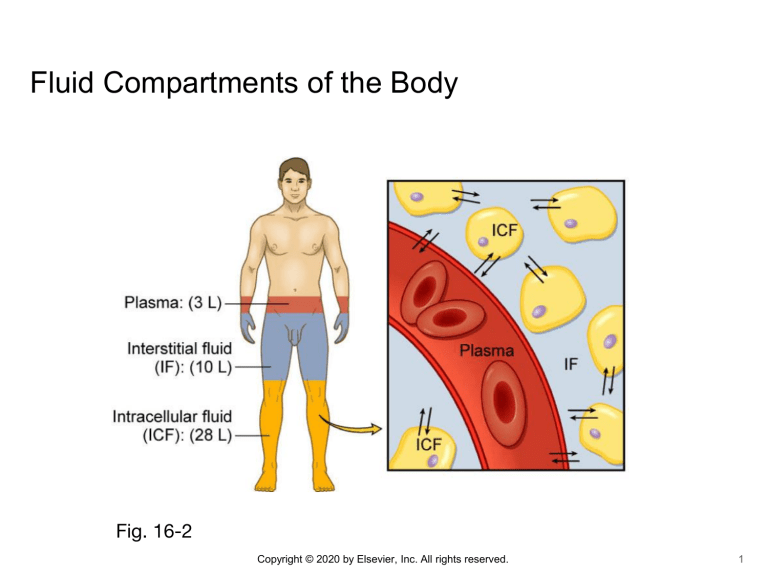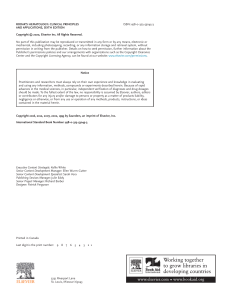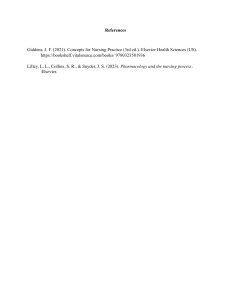
Fluid Compartments of the Body Fig. 16-2 Copyright © 2020 by Elsevier, Inc. All rights reserved. 1 Electrolytes ● Substances whose molecules dissociate into ions when placed in water ○ ○ Cations: positively charged Anions: negatively charged ● Concentration of electrolytes is expressed in milliequivalents (mEq)/L Copyright © 2020 by Elsevier, Inc. All rights reserved. 2 Electrolyte Composition ● ICF ○ ○ Prevalent cation is K+ Prevalent anion is PO43− ● ECF ○ ○ Prevalent cation is Na+ Prevalent anion is Cl− Copyright © 2020 by Elsevier, Inc. All rights reserved. 3 Concentrations of Cations and Anions in ICF and Plasma Fig. 16-3 Copyright © 2020 by Elsevier, Inc. All rights reserved. 4 Sodium-Potassium Pump Fig. 16-5 Copyright © 2020 by Elsevier, Inc. All rights reserved. 5 Osmotic Movement of Fluids ● The osmolality of the fluid surrounding cells affects them ○ ○ ○ Isotonic—same as cell interior Hypotonic—solutes less concentrated than in cells/ hypoosmolar Hypertonic—solutes more concentrated than in cells/ hyperosmolar Copyright © 2020 by Elsevier, Inc. All rights reserved. 6 Regulation of Water Balance (1 of 5) ● Hypothalamic-pituitary regulation ○ ○ ○ Osmoreceptors in hypothalamus sense fluid deficit or increase Deficit stimulates thirst and antidiuretic hormone (ADH) release Decreased plasma osmolality (water excess) suppresses ADH release Copyright © 2020 by Elsevier, Inc. All rights reserved. 7 Regulation of Water Balance (2 of 5) ● Renal regulation ○ ○ Primary organs for regulating fluid and electrolyte balance Adjusting urine volume ■ Selective reabsorption of water and electrolytes ■ Renal tubules are sites of action of ADH and aldosterone Copyright © 2020 by Elsevier, Inc. All rights reserved. 8 Regulation of Water Balance (3 of 5) ● Adrenal cortical regulation ○ ○ ○ Releases hormones to regulate water and electrolytes Glucocorticoids ■ Cortisol Mineralocorticoids ■ Aldosterone Copyright © 2020 by Elsevier, Inc. All rights reserved. 9 Regulation of Water Balance (4 of 5) ● Cardiac regulation ○ ○ ○ Natriuretic peptides are antagonists to the RAAS Hormones made by cardiomyocytes in response to increased atrial pressure They suppress secretion of aldosterone, renin, and ADH to decrease blood volume and pressure Copyright © 2020 by Elsevier, Inc. All rights reserved. 10 Regulation of Water Balance (5 of 5) ● GI regulation ○ ○ ○ Oral intake accounts for most water Small amounts of water are eliminated by GI tract in feces Diarrhea and vomiting can lead to significant fluid and electrolyte loss Copyright © 2020 by Elsevier, Inc. All rights reserved. 11 Gerontologic Considerations ● Structural changes in kidneys decrease ability to conserve water ● Hormonal changes include a decrease in renin and aldosterone and increase in ADH and ANP ● Subcutaneous tissue loss leads to increased moisture lost Copyright © 2020 by Elsevier, Inc. All rights reserved. 12 Fluid and Electrolyte Imbalances ● Directly caused by illness or disease (burns or heart failure) ● Result of therapeutic measures (colonoscopy preparation, diuretics) Copyright © 2020 by Elsevier, Inc. All rights reserved. 13 Sodium ● Imbalances typically associated with parallel changes in osmolality ● Plays a major role in ○ ○ ○ ○ ECF volume and concentration Generating and transmitting nerve impulses Muscle contractility Regulating acid-base balance Copyright © 2020 by Elsevier, Inc. All rights reserved. 14 Hypernatremia ● High serum sodium may occur with inadequate water intake, excess water loss or sodium gain ● Causes hyperosmolality leading to cellular dehydration ● Primary protection is thirst Copyright © 2020 by Elsevier, Inc. All rights reserved. 15 Hypernatremia: Causes ● Model ● Medications, meals ● Osmotic diuretics ● Diabetes insipidus ● Excessive water loss ● Low water intake Copyright © 2021 by NurseTim, Inc. All rights reserved. Hypernatremia ● Manifestations ○ ○ ○ Thirst Changes in mental status, ranging from drowsiness, restlessness, confusion and lethargy to seizures and coma Symptoms of fluid volume deficit Copyright © 2020 by Elsevier, Inc. All rights reserved. 17 Hypernatremia: Signs & Symptoms ● Fried ● Fever (low grade), flushed skin ● Restless and irritable ● Increased fluid retention and increased BP ● Edema (peripheral and pitting) ● Decreased urinary output, dry mouth Copyright © 2021 by NurseTim, Inc. All rights reserved. Nursing Diagnoses ○ ○ ○ ○ Electrolyte imbalance Fluid imbalance Risk for injury Potential complication: Seizures and coma Copyright © 2020 by Elsevier, Inc. All rights reserved. 19 Nursing Implementation ○ ○ ○ ○ Treat underlying cause Primary water deficit—replace fluid orally or IV with isotonic or hypotonic fluids Excess sodium—dilute with sodium-free IV fluids and promote sodium excretion with diuretics Reduce level gradually Copyright © 2020 by Elsevier, Inc. All rights reserved. 20 Hyponatremia ● Results from loss of sodium-containing fluids and/or from water excess ● Clinical manifestations ○ ○ Mild—headache, irritability, difficulty concentrating. More severe—confusion, vomiting, seizures, coma Copyright © 2020 by Elsevier, Inc. All rights reserved. 21 Hyponatremia: Signs & Symptoms ● ● ● ● ● ● ● ● ● Salt Loss Stupor and coma Anorexia, N&V Lethargy Tendon reflexes decreased Limp muscles (weakness) Orthostatic hypotension Seizures and headaches Stomach cramping Copyright © 2021 by NurseTim, Inc. All rights reserved. Nursing Implementation If the cause is water excess, ○ ○ ○ Fluid restriction may be only treatment Loop diuretics and demeclocycline Severe symptoms (seizures) ■ Give small amount of IV hypertonic saline solution (3% NaCl) Copyright © 2020 by Elsevier, Inc. All rights reserved. 23 Nursing Implementation ● If the cause is abnormal fluid loss, ○ ○ ○ ○ Fluid replacement with isotonic sodium-containing solution Encouraging oral intake Withholding diuretics Drugs that block vasopressin (ADH) ■ Convaptan (Vaprisol) ■ Tolvaptan (Samsca) Copyright © 2020 by Elsevier, Inc. All rights reserved. 24 Chloride ● Primary anion in ECF (nl: 95-108 mEq/L) ● Combines w/Na to create neutrality ● Assists in reabsorption of Na in kidney ● Essential for reabsorbing hydrogen ion to buffer alkalosis ● Lost through vomiting, excessive sweating ● Normally excreted in urine Potassium (1 of 2) ● Major ICF cation ● Necessary for ○ ○ ○ ○ Resting membrane potential of nerve and muscle cells Cellular growth Maintenance of cardiac rhythms Acid-base balance Copyright © 2020 by Elsevier, Inc. All rights reserved. 26 Potassium (2 of 2) ● Sources ○ ○ ○ ○ ○ Protein-rich foods Fruits and vegetables Salt substitutes Potassium medications (PO, IV) Stored blood ● Regulated by kidneys Copyright © 2020 by Elsevier, Inc. All rights reserved. 27 Hyperkalemia ● High serum potassium caused by ○ ○ ○ ○ Impaired renal excretion Shift from ICF to ECF Massive intake of potassium Some drugs ● Most common in renal failure ● Common in massive cell destruction – Burn, crush injury, tumor lysis Copyright © 2020 by Elsevier, Inc. All rights reserved. 28 Hyperkalemia: Causes ● ● ● ● ● ● ● ● Machine Medications - ACE inhibitors, NSAIDS Acidosis – metabolic & respiratory Cellular destruction – burns, traumatic injury Hypoaldosteronism, hemolysis Intake – excessive Nephrons, renal failure Excretion – impaired Copyright © 2021 by NurseTim, Inc. All rights reserved. Hyperkalemia ● Manifestations ○ ○ ○ ○ ○ Dysrhythmias Fatigue, confusion Tetany, muscle cramps Weak or paralyzed skeletal muscles Abdominal cramping or diarrhea Copyright © 2020 by Elsevier, Inc. All rights reserved. 30 Hyperkalemia: Manifestations ● Murder ● Muscle weakness ● Urine, oliguria, anuria ● Respiratory distress ● Decreased cardiac contractility ● ECG changes ● Reflexes, hyperreflexia, or areflexia (flaccid) ● Copyright © 2021 by NurseTim, Inc. All rights reserved. ECG Effects of Hyperkalemia Fig. 16-14 Copyright © 2020 by Elsevier, Inc. All rights reserved. 32 Potassium Imbalances: Hyperkalemia Clinical manifestations Hyperkalemia in Acidosis • As blood [H+] rises in cases of acidosis, more H+ ions are pumped intracellularly in exchange for K+ ions that are pumped extracellularly to maintain electrical neutrality. Nursing Implementation ○ ○ ○ ○ ○ Stop oral and parenteral K+ intake Increase K+ excretion (diuretics, dialysis, Veltessa and/or Kayexalate) Force K+ from ECF to ICF by IV insulin with dextrose and a β-adrenergic agonist or sodium bicarbonate Stabilize cardiac cell membrane by administering calcium gluconate IV Use continuous ECG monitoring Copyright © 2020 by Elsevier, Inc. All rights reserved. 35 Nursing Implication Hyperkalemia ● CBIGKD “see big kid” ● Calcium chloride or gluconate ● Bicarbonate ● Insulin ● Glucose ● Kayexalate ● Dialysis/Diuretics Hypokalemia (1 of 2) ● Low serum potassium caused by ○ ○ ○ ○ ○ Increased loss of K+ via the kidneys or gastrointestinal tract Increased shift of K+ from ECF to ICF Dietary K+ deficiency (rare) Renal losses from diuresis Magnesium deficiency Copyright © 2020 by Elsevier, Inc. All rights reserved. 37 Hypokalemia (2 of 2) ● Manifestations ○ ○ ○ ○ ○ Cardiac most serious Skeletal muscle weakness (legs) Weakness of respiratory muscles Decreased GI motility Hyperglycemia Copyright © 2020 by Elsevier, Inc. All rights reserved. 38 Hypokalemia: Signs & Symptoms ● ● ● ● ● ● ● ● 6 L’s Lethargy Leg cramps Limp muscles Low, shallow respirations Lethal cardiac dysrhythmias Lots of urine (polyuria) Copyright © 2021 by NurseTim, Inc. All rights reserved. ECG Effects of Hypokalemia Fig. 16-14 Copyright © 2020 by Elsevier, Inc. All rights reserved. 40 Potassium Imbalances Hypokalemia ● Clinical Manifestations: ○ “SUCTION” ● Skeletal muscle weakness ● U wave ● Constipation ● Toxic effects of digoxin ● Irregular, weak pulse ● Orthostatic hypotension ● Numbness (paresthesia) Nursing Implementation ○ ○ ○ ○ ○ KCl supplements orally or IV Always dilute IV KCl NEVER give KCl via IV push or as a bolus Should not exceed 10 mEq/hr Use an infusion pump Copyright © 2020 by Elsevier, Inc. All rights reserved. 42 ECG changes associated with alterations in potassium status Calcium ● Functions ○ ○ ○ ○ ○ Formation of teeth and bone Blood clotting Transmission of nerve impulses Myocardial contractions Muscle contractions Copyright © 2020 by Elsevier, Inc. All rights reserved. 44 Calcium ● Obtained from dietary intake ● Need vitamin D to absorb ● Present in bones and plasma ○ Ionized calcium is biologically active ● Changes in pH and serum albumin affect levels ● Inverse relationship with phosphorus ● Blocks sodium transport ● Stabilizes cell membrane Copyright © 2020 by Elsevier, Inc. All rights reserved. 45 Calcium ● Balance controlled by ○ ○ Parathyroid hormone ■ Increases bone resorption, GI absorption, and renal tubule reabsorption of calcium Calcitonin ■ Increases calcium deposition into bone, increases renal calcium excretion, and decreases GI absorption Copyright © 2020 by Elsevier, Inc. All rights reserved. 46 Calcium ● Balance controlled by – – – Parathyroid hormone Calcitonin Vitamin D Hypercalcemia (1 of 2) ● High levels of serum calcium caused by ○ Hyperparathyroidism (two-thirds of cases) – Malignancy – Vitamin D overdose – Prolonged immobilization Copyright © 2020 by Elsevier, Inc. All rights reserved. 48 Hypercalcemia (2 of 2) - Manifestations ● Dec. excitability – Skeletal muscle – Cardiac muscle – Nervous system ○ ○ ○ ○ ○ Fatigue, lethargy, weakness, confusion Hallucinations, seizures, coma Dysrhythmias Bone pain, fractures, nephrolithiasis Polyuria, dehydration Copyright © 2020 by Elsevier, Inc. All rights reserved. 49 Hypercalcemia: Signs & Symptoms ● Groans, Moans, Bones, Stones, and Overtones ● Groans: constipation ● Moans: pain – joint aches ● Bones: loss of calcium from bones, bone metastasis ● Stones: kidney stones ● Overtones: psychiatric overtones – depression, confusion ● Copyright © 2021 by NurseTim, Inc. All rights reserved. Nursing Implementation ○ ○ ○ ○ ○ ○ ○ ○ Excretion of Ca with loop diuretic Low calcium diet Increased weight-bearing activity Increased fluid intake Hydration with isotonic saline infusion Bisphosphonates—gold standard Synthetic calcitonin (IM or SC) Mobilization Copyright © 2020 by Elsevier, Inc. All rights reserved. 51 Hypocalcemia (1 of 2) ● Low serum Ca levels caused by ○ ○ ○ ○ ○ ○ ○ Decreased production of PTH Multiple blood transfusions Alkalosis Increased calcium loss Acute pancreatitis Multiple blood transfusions Decreased intake Copyright © 2020 by Elsevier, Inc. All rights reserved. 52 Hypocalcemia (2 of 2) ● Manifestations ○ ○ ○ ○ ○ Positive Trousseau’s or Chvostek’s sign Laryngeal stridor Dysphagia Numbness and tingling around the mouth or in the extremities Dysrhythmias Copyright © 2020 by Elsevier, Inc. All rights reserved. 53 Hypocalcemia: Signs & Symptoms ● Cats ● Convulsions ● Arrhythmias ● Tetany ● Spasms and stridor ● Copyright © 2021 by NurseTim, Inc. All rights reserved. Tests for Hypocalcemia Fig. 16-15 Copyright © 2020 by Elsevier, Inc. All rights reserved. 55 Nursing Implementation ○ ○ ■ ○ ○ ○ Treat cause Calcium and Vitamin D supplements Not IM to avoid local reactions IV calcium gluconate Rebreathe into paper bag Treat pain and anxiety to prevent hyperventilation-induced respiratory alkalosis Copyright © 2020 by Elsevier, Inc. All rights reserved. 56 Phosphate ● Primary anion in ICF ● Essential to function of muscle, red blood cells, and nervous system ● Deposited with calcium for bone and tooth structure ● Involved in acid-base buffering system, ATP production, cellular uptake of glucose, and metabolism of carbohydrates, proteins, and fats Copyright © 2020 by Elsevier, Inc. All rights reserved. 57 Phosphate ● Serum levels controlled by parathyroid hormone ● Maintenance requires adequate renal functioning ● Reciprocal relationship with calcium Copyright © 2020 by Elsevier, Inc. All rights reserved. 58 Hyperphosphatemia (1 of 3) ● High serum PO43− caused by ○ ○ ○ ○ Acute kidney injury or chronic kidney disease Chemotherapy Excess intake of phosphate or vitamin D Hypoparathyroidism Copyright © 2020 by Elsevier, Inc. All rights reserved. 59 Hyperphosphatemia (2 of 3) ● Manifestations ○ Tetany, muscle cramps, paresthesias, hypotension, dysrhythmias, seizures (hypocalcemia) ○ Calcified deposition in soft tissue such as joints, arteries, skin, kidneys, and corneas (cause organ dysfunction) ○ Neuromuscular irritability and tetany (hypocalcemia) ○ Calcified deposition in soft tissue such as joints, arteries, skin, kidneys, and corneas (can cause organ dysfunction) Copyright © 2020 by Elsevier, Inc. All rights reserved. 60 Hyperphosphatemia (3 of 3) ● Management ○ ○ ○ ○ ○ ○ ○ Identify and treat underlying cause Restrict intake of foods and fluids containing phosphorus Oral phosphate-binding agents Hemodialysis Volume expansion and forced diuresis Correct any hypocalcemia Adequate hydration and correction of hypocalcemic conditions Copyright © 2020 by Elsevier, Inc. All rights reserved. 61 Hypophosphatemia (1 of 3) ● Low serum PO43− caused by ○ ○ ○ ○ Malnourishment/malabsorption Diarrhea Use of phosphate-binding antacids Inadequate replacement during parenteral nutrition Copyright © 2020 by Elsevier, Inc. All rights reserved. 62 Hypophosphatemia (2 of 3) ● Manifestations ○ ○ ○ ○ CNS depression Muscle weakness and pain Respiratory and heart failure Rickets and osteomalacia Copyright © 2020 by Elsevier, Inc. All rights reserved. 63 Hypophosphatemia (3 of 3) ● Management ○ ○ ○ Oral supplementation Ingestion of foods high in phosphorus IV administration of sodium or potassium phosphate ■ Monitor serum calcium and phosphorus levels every 6 to 12 hours Copyright © 2020 by Elsevier, Inc. All rights reserved. 64 Self Assessment ● The nurse anticipates that the patient with hyperphosphatemia secondary to renal failure will require a. calcium supplements. b. potassium supplements. c. magnesium supplements. d. fluid replacement therapy. Magnesium (1 of 2) ● Second most abundant intracellular cation ● Essential for proper neuromuscular function ● Levels controlled by kidneys ● Cofactor in enzyme for metabolism of carbohydrates ● Required for DNA and protein synthesis ● Blood glucose control ● BP regulation ● Needed for ATP production Copyright © 2020 by Elsevier, Inc. All rights reserved. 66 Magnesium (2 of 2) ● Acts directly on myoneural junction ● Important for normal cardiac function ● 50% to 60% contained in bone ○ ● Absorbed in GI tract ● Excreted by kidneys Only 1% in ECF Copyright © 2020 by Elsevier, Inc. All rights reserved. 67 Hypermagnesemia (1 of 3) ● High serum Mg caused by ○ ○ ○ Increased intake of products containing magnesium when renal insufficiency or failure is present Excess IV magnesium administration Advanced CKD Copyright © 2020 by Elsevier, Inc. All rights reserved. 68 Hypermagnesemia (2 of 3) ● Manifestations ○ ○ ○ ○ ○ ○ Hypotension, facial flushing Lethargy Nausea and vomiting Impaired deep tendon reflexes Muscle paralysis Respiratory and cardiac arrest Copyright © 2020 by Elsevier, Inc. All rights reserved. 69 Hypermagnesemia (3 of 3) ● Management ○ ○ ○ ○ Prevention first—restrict magnesium intake in high-risk patients IV CaCl or calcium gluconate if symptomatic Fluids and IV furosemide to promote urinary excretion Dialysis Copyright © 2020 by Elsevier, Inc. All rights reserved. 70 Hypomagnesemia ● Low serum Mg caused by ○ ○ ○ ○ ○ ○ Prolonged fasting or starvation Chronic alcoholism Fluid loss from GI tract Prolonged parenteral nutrition without supplementation Diuretics, proton-pump inhibitors Hyperglycemic osmotic diuresis Copyright © 2020 by Elsevier, Inc. All rights reserved. 71 Hypomagnesemia ● Manifestations ○ Resembles hypocalcemia ■ Muscle cramps, tremors ■ Hyperactive deep tendon reflexes ■ Chvostek’s and Trousseau’s signs ○ ○ ■ Confusion, vertigo, seizures Dysrhythmias Corresponding hypocalcemia and hypokalemia Copyright © 2020 by Elsevier, Inc. All rights reserved. 72 Hypomagnesemia Manifestations ● ● ● ● 3 T’s Tremors Twitching Tetany ● ● ● ● ● ● ● ● STARVED SZ Tetany Anorexia & Arrhythmias Rapid HR Vomiting Emotional lability DTRs (hyperactive) Hypomagnesemia ● Management ○ ○ ○ ○ Treat underlying cause Oral supplements Increase dietary intake Parenteral IV or IM magnesium when severe Copyright © 2020 by Elsevier, Inc. All rights reserved. 74 Audience Response Question (1 of 2) A patient is admitted with renal failure and an arterial blood pH level of 7.29. Which lab result would the nurse expect? a. Serum sodium 138 mEq/L b. Serum glucose 145 mg/dL c. Serum potassium 5.9 mEq/L d. Serum magnesium 0.4 mg/dL Copyright © 2020 by Elsevier, Inc. All rights reserved. 75 Audience Response Question (2 of 2) Answer: C Serum potassium 5.9 mEq/L Copyright © 2020 by Elsevier, Inc. All rights reserved. 76








